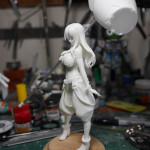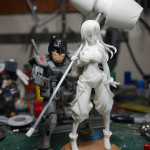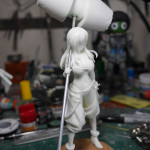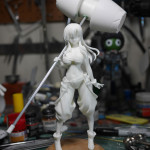I started work on this kit this past weekend. For this project, I’m going to try documenting the entire process with video as I did with the SD Glaug kit. Over the past few days, I’ve created four videos covering the kit unpacking and pinning; initial sanding; cleaning; and initial priming session. The figure is Sena Kashiwazaki (æŸå´Žæ˜Ÿå¥ˆ) from Haganai (僕ã¯å‹é”ãŒå°‘ãªã„), and is cosplaying a character within a game she played in the manga/anime. The kit was made available from ã‚ューズQ (QuesQ) at Wonfes 2015 then a few weeks later from their online shop.
The videos are after the jump.
The first video shows the unpacking of the kit, some initial flash clean up, and the pinning process. The nice thing about thie kit is that a majority of the parts had guide holes to help align the pins. A good number of anime garage kits do not have these guides, so there is some guess work involved and some other techniques involved to pin the kit. The kit design made this process amazingly fast and easy.
Once the kit is pinned together, the next video covers the initial sanding. The initial sanding cleans up any visible mold lines, excess flash, and other surface defects. Sanding sticks, metal files, sanding pads, and a flexi-file are used.
After the initial sanding, the surface of the parts need to be cleaned. When unpacking the kit, the surface of the parts will have an oily feel. This is a layer of mold release film that is on the surface of the parts. This helps extend mold life and facilitate the removal of the parts from the molds; however, this mold release will prevent primer and paint from sticking to the surface of the kit. The parts must be soaked in some kind of a degreaser. For this video, I’m soaking the kit parts in purple power, an industrial strength cleaner. The parts are soaked over night, then rinsed off in some clean water, and placed in an ultrasonic cleaner for a scrub session, then pulled out and dried on some paper towels.
Once the parts have had time to dry, they are placed on skewers or held by alligator clips on skewers. The parts are ready for the first priming session. Using an airbrush, Mr Resin Primer is sprayed on the parts first with a light misting coat at about 3-4 inches away from the parts; then a heavier coat sprayed at about 1 to 2 inches from the part. The technique is to create an intermediate layer of paint that acts as a bridge between the dry surface and the paint. Without the mist layer, the paint has a greater chance of not sticking well and just pooling. When spraying heavy, the idea is to get the surface just start looking glossy/wet and then stop spraying the paint. There is a threshold from where the paint will start pooling if you continue to spray after the surface starts to look glossy/wet. At the point, the part is completely primed. The primer will dry to a flat finish.
More videos to follow as I continue to build.







